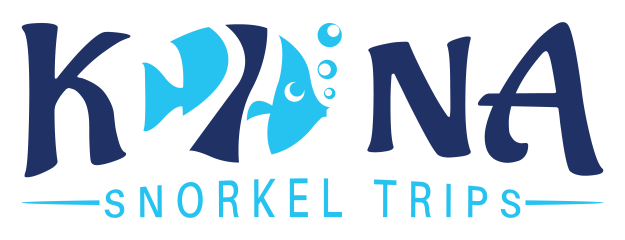Your Guide to Whale Watching Kona Big Island
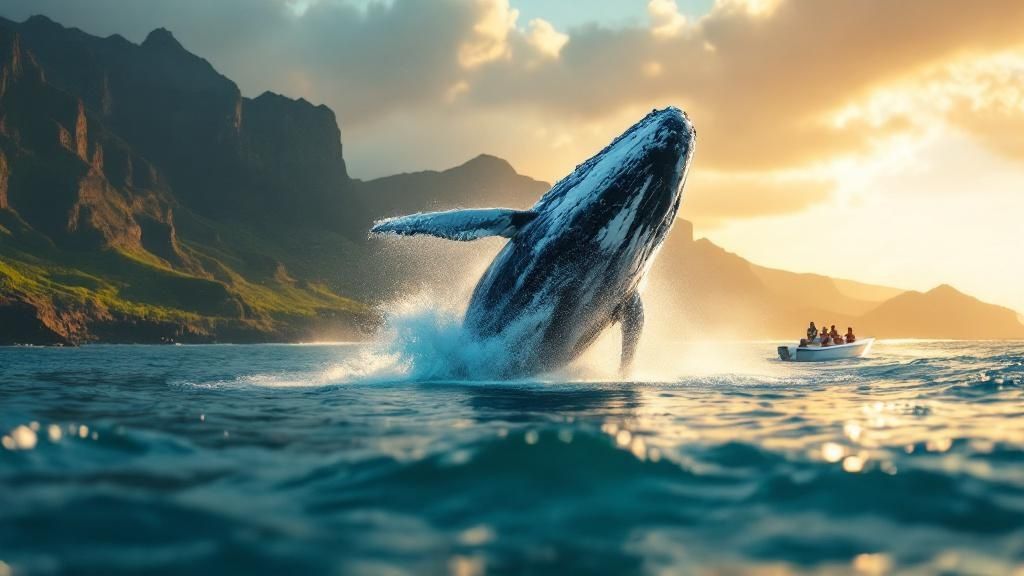
Picture this: the calm, turquoise water of the Kona coast suddenly explodes as a 40-ton humpback whale throws its entire body out of the sea. That's the sheer magic of whale watching in Kona, a truly world-class spot to witness one of nature's most incredible journeys.
Your Kona Whale Watching Adventure Awaits
If you're dreaming of an unforgettable encounter with these gentle giants, you've come to the right place. This guide is your complete playbook. We'll get into why Kona's calm, sheltered waters are the perfect nursery for humpback whales, the absolute best time to book your trip, and how to pick the tour that's just right for you.
Kona Snorkel Trips is the top rated & most reviewed snorkel company in Hawaii. We live and breathe these waters, and the reviews below are a testament to our passion for creating amazing marine adventures for our guests.
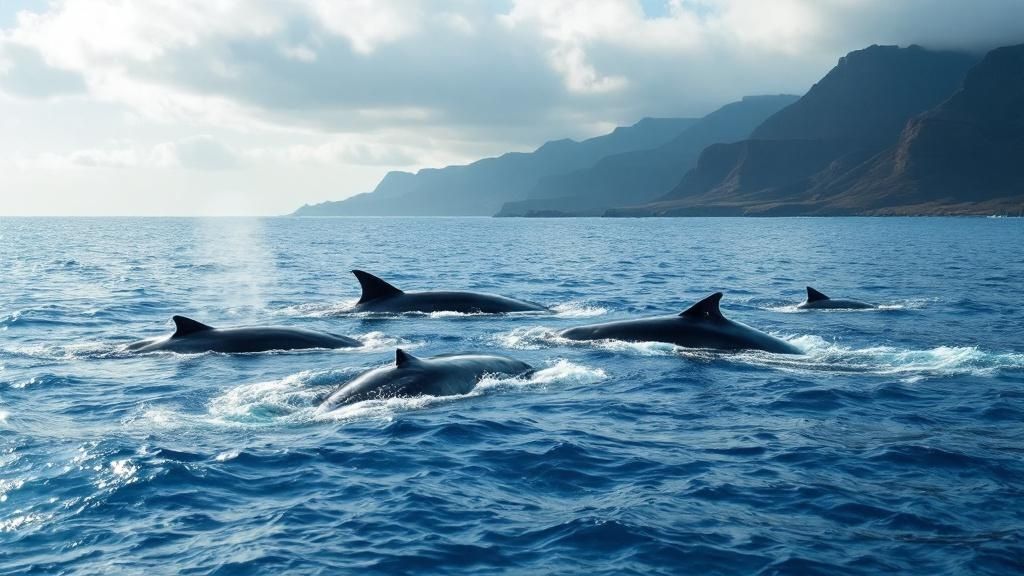
What to Expect from This Guide
Going on a whale watching tour is so much more than a simple boat ride; it’s a chance to connect with the ocean's most magnificent creatures. Seeing a humpback breach against the backdrop of the Big Island’s volcanic coastline is one of those memories that sticks with you forever. This guide is built to get you ready for that exact moment.
We'll cover everything you need to know to make your whale watching Kona Big Island trip a success. From understanding the whales' migration routes to learning what their behaviors mean, you'll walk away with a much deeper appreciation for this annual spectacle.
The yearly trip humpback whales make from Alaska to Hawaii is one of the longest migrations of any mammal, stretching roughly 3,000 miles across the open ocean. They're headed for the warm, protected Hawaiian waters, which serve as their essential breeding and calving grounds.
Your Journey Begins Here
We’ll walk you through all the essential details for planning your adventure. You'll learn the key differences between the various types of tours out there and get the inside scoop to help you choose an experience that perfectly fits what you’re looking for.
Our goal is to give you the practical knowledge you need to book with confidence and soak up every second of your time on the water. For an even deeper dive, check out our complete guide to whale watching on the Big Island of Hawaii. By the time you're done, you'll be more than ready for an incredible day watching these gentle giants play in their winter paradise.
Why Kona Is a Premier Whale Watching Hotspot
So, what is it about Kona that makes it a global hotspot for humpback whales? It’s not just luck; it’s a perfect storm of geography, biology, and one of the most incredible journeys in the animal kingdom.
Every year, thousands of North Pacific humpback whales travel a staggering 3,000 miles from the cold, food-rich waters of Alaska. They leave their feeding grounds behind for the warm, protected embrace of Hawaii with one thing on their minds: family. This isn’t a vacation for them. It’s the most critical time of their lives—a safe place to give birth, nurse their new calves, and find a mate.
The Kona and Kohala coasts on the Big Island offer the exact five-star accommodations these gentle giants are looking for. Think of the island’s massive volcanoes, Mauna Loa and Hualalai, as colossal bodyguards. They stand so tall that they create a "wind shadow" on the western coast, blocking the powerful trade winds and leaving the ocean remarkably calm. This natural shelter creates the perfect, serene nursery for mothers and their vulnerable young.
An Ideal Marine Nursery
The waters off Kona aren't just calm—they're also deep and clear, which is the ideal combination for a whale nursery. This unique environment provides a few key advantages, making it their preferred destination year after year.
- Protection From Predators: The deep, sheltered bays make it tough for predators like orcas to hunt newborn calves, which are incredibly vulnerable in their first few weeks.
- Optimal Birthing Conditions: The warm water is a game-changer for newborns. They have a much thinner layer of blubber than adults, and the balmy Hawaiian seas help them save precious energy that would otherwise be spent just trying to stay warm.
- A Clear Stage for Communication: Sound travels incredibly well underwater, and humpbacks are famous for their complex, haunting songs. The deep channels and calm surface here create the perfect acoustic environment for whales to communicate across miles.
This is why whale watching in Kona, Big Island is so profound. You're not just spotting whales from a boat; you're witnessing a vital chapter of their lives play out in a place perfectly designed for their needs.
The Science of the Sighting Hotspot
The proof is in the numbers. Since 1996, dedicated volunteers have run the annual Sanctuary Ocean Count, meticulously tracking whale sightings across the islands. The data consistently points to one area above all others: the Kohala Coast, just north of Kona.
Sighting rates here are often two to three times higher than anywhere else on the Big Island. During the peak months of January and February, it's pretty common for observers to spot anywhere from 3 to 6 whales every 15 minutes.
This incredible migration transforms a simple boat tour into a genuine ecological experience. When you understand why the whales are here, every breach and tail slap becomes so much more meaningful.
To get the full picture and make the most of your trip, it helps to understand how the season unfolds from the first arrivals to the last goodbyes. Dive deeper with our detailed guide to the Big Island whale watching season. This knowledge will turn your tour from simple sightseeing into a true appreciation for one of nature's greatest shows.
Timing Your Trip for Peak Whale Activity
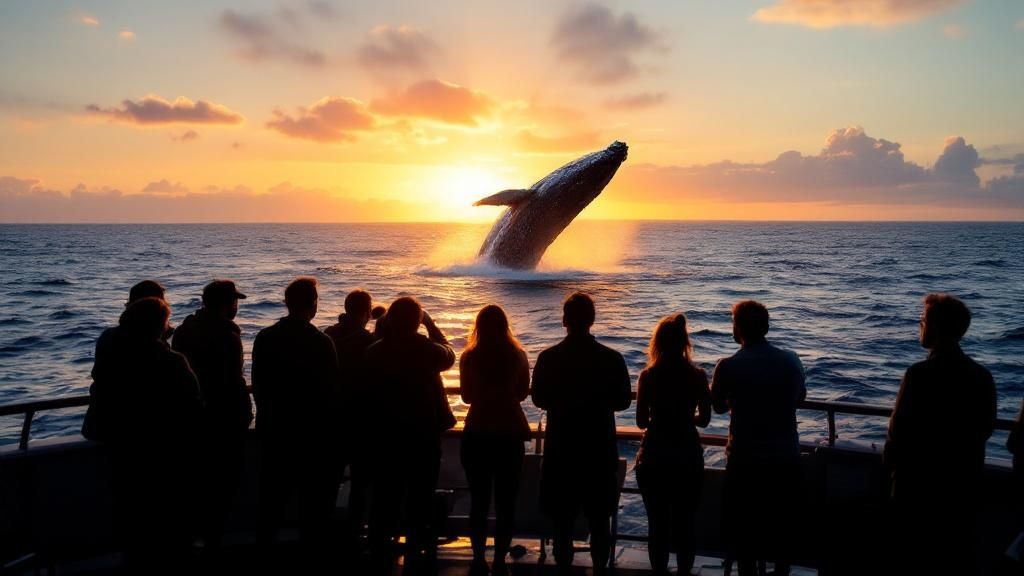
While you can spot humpbacks off the Big Island from December through April, timing is everything. Planning your whale watching Kona Big Island adventure around the absolute peak of the season is the difference between a good trip and an unforgettable one. It massively boosts your chances of seeing the most spectacular whale behaviors.
Think of the season as a slow-building performance. The first whales to show up in late fall are usually the males, full of energy and ready to compete for mates. As the weeks go by, more and more whales arrive, filling the stage until it's a full-blown festival of flukes and breaches.
If you want the absolute best shot at seeing the most whales, aim for January and February. These are, without a doubt, the peak months. The waters off the Kona coast are practically buzzing with thousands of humpbacks. It’s your best opportunity to witness the whole story of whale life—from the intense, powerful "heat runs" of competing males to the gentle, tender moments between a mother and her brand-new calf.
The Rhythm of the Season
Understanding how the season unfolds month by month helps you pick the perfect time for the experience you’re hoping for. Every part of the season has its own unique magic.
Here's a quick look at what the whale watching season looks like from beginning to end, so you can plan your trip around the kind of action you want to see.
Kona Whale Watching Season At-a-Glance
| Month | Whale Activity Level | What to Expect |
|---|---|---|
| December | High | The early arrivals are here and putting on a show. Lots of breaching and surface action as males compete. The season is just kicking off, and the energy is palpable. |
| January | Peak | The highest concentration of whales. The waters are full of mothers and newborn calves. It's the best time to see babies learning to breach and play. |
| February | Peak | Activity remains at its height. This is your best chance to see the full range of behaviors, from competitive pods to nurturing mothers. The show is in full swing. |
| March | High | The numbers are still strong, but you'll notice a lot of mother-calf pairs. They're spending time near the surface, preparing for the long swim back to Alaska. |
| April | Moderate | The season's grand finale. Sightings become a bit less frequent as the last groups—mostly moms and their growing calves—begin their journey north. |
This natural calendar gives you a great framework for planning. You can see that while the whole season is special, January and February truly offer the most action-packed experience.
The peak viewing window in January and February offers the highest density of whales, including the heartwarming sight of mothers teaching their calves essential survival skills, a truly unforgettable part of the whale watching Kona Big Island experience.
Morning vs. Afternoon Tours: Which Is Better?
So, you’ve picked your dates. Now for the next big question: morning or afternoon? Honestly, both are fantastic, and the "best" choice really comes down to personal preference and what kind of vibe you're looking for.
Mornings in Kona are famous for one thing: glassy, calm water. The ocean is often like a mirror, which makes spotting spouts and breaches from far away incredibly easy. For photographers, that soft morning light is pure gold, letting you capture amazing shots without harsh glare. If you're someone who gets a little queasy on the water, the calmer morning seas are definitely your friend.
On the other hand, afternoons can bring a real uptick in whale acrobatics. As the day warms up, the whales often seem to get more playful. The trade winds might kick up a bit, creating more chop, but this can actually spur on more active behaviors like tail slapping and full-body breaches. Plus, that afternoon light creates some pretty dramatic silhouettes as the sun starts to dip.
There's no wrong answer during peak season, as the whales are active all day. It’s all about weighing the pros and cons to make the best choice for your crew.
Choosing the Right Whale Watching Tour in Kona
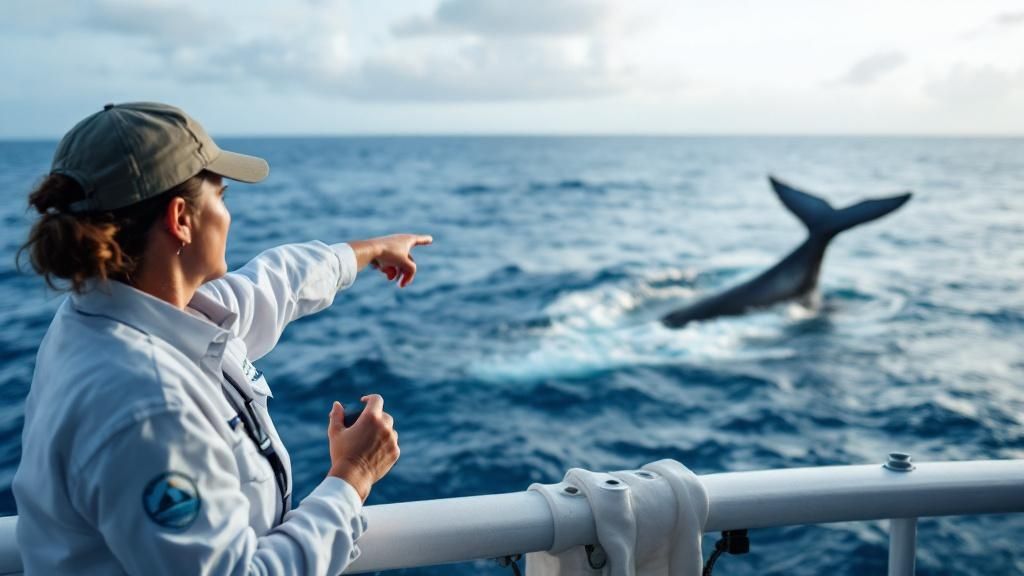
With so many fantastic operators offering whale watching in Kona, Big Island, picking the right one can feel like a tough choice. But don't worry, the key is simply finding an experience that fits your group’s vibe, comfort level, and spirit of adventure. Honestly, the biggest factor shaping your day is the type of boat you choose.
Each vessel offers a totally different perspective. Big, steady catamarans are a dream for families or anyone wanting a super smooth ride, while the smaller rafts get you right down to the water for a more personal, thrilling feel. Let's break down the differences so you can book the perfect trip.
Every winter, 1,000 or more humpback whales make their way to Hawaiian waters, fueling a whale watching industry valued at around $20 million. This means you've got plenty of great options to see not just humpbacks, but also dolphins, mantas, and all the other incredible marine life that calls the Kona coast home. If you're curious about all the wildlife you might see, Hawaiian Adventures Kona has some great info.
Comparing Vessel Types
Your choice of boat isn't just about getting from point A to point B; it completely defines how you'll experience the whales. Here’s a look at the most common options in Kona to help you find the perfect match.
Large Catamarans and Powerboats
Think of these as the floating living rooms of the whale watching world. They're built for comfort, with tons of space and an incredibly stable ride.
- Best for: Families with young kids, larger groups, photographers needing a steady shot, and anyone who gets a little queasy on the water.
- Amenities: You'll usually find the comforts of home here, like onboard restrooms, shaded seating, and plenty of room to stretch your legs. Many even throw in snacks and drinks.
- The View: The higher deck gives you an awesome panoramic view, making it way easier to spot those distant spouts and breaches.
Small, Fast Rafts (Zodiac-Style)
If you're after a real thrill and a more intimate encounter, a rigid-hulled inflatable boat (often called a Zodiac or raft) is the way to go. These boats are quick, nimble, and sit right on the water.
- Best for: Adventurous couples, small groups, and anyone who wants an exhilarating, close-to-the-action experience.
- The Vibe: This is a wilder ride, no doubt about it. You’ll feel the ocean spray and hear the whales breathe from an unforgettable eye-level perspective.
- Considerations: These tours often have age or mobility restrictions and offer minimal amenities. It’s all about the adventure.
Choosing a tour operator committed to responsible wildlife viewing is so important. The best companies strictly follow federal regulations, keeping a respectful distance to ensure the whales' safety. This actually leads to a better, more natural encounter for everyone involved.
Key Factors to Consider Before You Book
Beyond the boat, a few other details will help you lock in the perfect trip. Thinking through these points beforehand will make booking a breeze.
- Group Size: Are you looking for a lively social atmosphere or a quiet, personalized trip? Tours can range from small six-passenger boats to larger vessels holding 50 or more guests.
- Tour Duration: Most trips last between two and four hours. A shorter tour is great if you have kids with short attention spans, while a longer one gives you more time on the water to find really active pods.
- Onboard Amenities: What does your group absolutely need? Are restrooms a must? Do you want snacks and drinks included? Nailing down these preferences will help you narrow your search.
Questions to Ask Your Tour Operator
To make sure you're booking the right trip, don't be afraid to ask a few questions before you commit. Any good company will be happy to give you the rundown.
- Do you have a hydrophone on board? A hydrophone is an underwater microphone that lets you listen to the beautiful, complex songs of the male humpback whales. It adds a whole other dimension to the experience.
- What is your sighting guarantee policy? While sightings are almost a sure thing in peak season, whales are still wild animals. Many companies offer a guarantee that if you don't see whales, you can come back again for free.
- Who is leading the tour? Ask about the crew! Are they trained naturalists or marine biologists? A knowledgeable guide can turn a simple sightseeing trip into a fascinating learning experience.
- How do you practice responsible whale watching? Confirm that they follow the 100-yard approach rule and adhere to NOAA's guidelines. This is how you know you're supporting an ethical operation that puts the whales first.
Decoding Humpback Whale Behaviors
Going on a whale watching tour in Kona, Big Island, isn't just about seeing a spout of water on the horizon. It's about getting a front-row seat to the surprisingly complex world of humpback whales. When you start to understand what their behaviors mean, a great sighting turns into an unforgettable story. This is your guide to translating the incredible actions you might witness out on the water.
Every tour is a unique adventure, and since these are wild animals, there's never a guarantee of what you'll see. But knowing what to look for adds a whole new layer to the experience. When a 40-ton animal decides to communicate, it does so with spectacular power.
The sheer number of whales in Hawaiian waters during peak season is mind-boggling. To give you an idea, surveys on a single day in January 2022 across 45 sites reported 278 whale sightings. The Big Island's calm leeward coast is a critical nursery for mothers and their newborn calves, making it one of the best places on Earth for these encounters.
Common Humpback Behaviors to Look For
When you're out on the boat, keep your eyes peeled for these awe-inspiring displays. Each one is a piece of the puzzle, revealing a little something about what the whale might be up to.
- The Breach: This is the big one—the iconic, full-body leap out of the water that everyone dreams of seeing. A whale launches its entire body into the air before crashing back down with a colossal splash. Scientists think it could be a form of long-range communication, a way to shake off pesky parasites, or maybe just an expression of pure joy.
- The Tail Slap (Lobtailing): You'll see the whale lift its massive fluke (tail) high out of the water and slam it down hard on the surface. This creates a deafening, cannon-like sound that can travel for miles underwater. It’s often used as a warning to other whales or a way to get their attention.
- The Pec Slap: Similar to a tail slap, this is when a whale rolls onto its side and repeatedly slaps its long pectoral fin against the water. Think of it as a friendly wave or another tool in their communication toolkit.
A single pectoral fin on an adult humpback can be up to 15 feet long—that's about one-third of its entire body length! Seeing one of those massive fins waving in the air is a sight you won't soon forget.
More Than Just Whales
While the humpbacks are the stars of the show, the Kona coast is a vibrant marine ecosystem teeming with other incredible wildlife. Your whale watching adventure often includes surprise appearances from other residents of these pristine waters.
The most common co-stars are the playful spinner dolphins. Famous for their incredible acrobatics, these dolphins often travel in large pods and love to surf the bow wave of boats, leaping and spinning clean out of the air. You might also spot graceful sea turtles (honu) surfacing for a breath or even the occasional pod of pilot whales. Our comprehensive guide to whale season in Hawaii provides more detail on the full range of marine life you can run into.
Interpreting the Action
Beyond the big, dramatic splashes, there are more subtle behaviors that offer clues into a whale’s world. Learning to spot these can really deepen your appreciation for just how intelligent and curious they are.
One of the most captivating behaviors is the spy-hop. This is when a whale positions itself vertically in the water and pokes its head straight up, sometimes just high enough to get its eyes above the surface. It's a sign of pure curiosity, as the whale takes a good, long look at its surroundings—and that includes you and your boat.
Remember, every single tour is different. Some days are packed with dramatic breaches and tail slaps, while others offer quiet, serene moments watching a mother and her calf rest on the surface. The real beauty of whale watching in Kona, Big Island, lies in this unpredictability. Go in with an open mind and a sense of wonder, and you're guaranteed to have an amazing experience, no matter what the whales decide to show you.
Got Questions About Whale Watching?
Even the most seasoned traveler has a few questions before heading out on the water. It's only natural. Getting the answers sorted out beforehand means you can just relax and soak it all in when the time comes. Here are some of the most common things people ask, with some straight-up advice to get you ready for an incredible day.
Think of this as your pre-trip briefing. We'll cover everything from what to stuff in your bag to what happens if the whales are playing hard to get. Our goal is simple: make sure your trip is comfortable, safe, and completely unforgettable.
What Should I Bring on a Whale Watching Tour?
A little preparation goes a long way in turning a good day into a great one. Packing the right gear is all about staying comfortable so you can focus on the main event.
Here are the essentials we never leave the dock without:
- Sun Protection: That Hawaiian sun is no joke, especially when it's bouncing off the water. You'll want reef-safe sunscreen, a good pair of polarized sunglasses to cut the glare, and a hat that won't fly off when the boat gets moving.
- Layers: It can get surprisingly cool and breezy out on the ocean, even on a sunny Kona day. A light jacket or windbreaker is perfect for adjusting to the changing temps.
- Camera and Binoculars: This is a big one. You’ll want to capture these moments! A camera with a zoom lens is your best friend for getting those incredible shots, and binoculars are amazing for spotting spouts and breaches in the distance. Pro tip: bring extra batteries.
- Motion Sickness Remedies: If you're even a little prone to seasickness, it's a good idea to take something before you leave the harbor, based on your doctor's advice. Staying hydrated and keeping your eyes on the horizon helps a ton, too.
Most tours will have water and maybe some snacks, but it never hurts to check when you book. Tossing a few extra snacks in your bag, especially if you have kids with you, is always a smart move.
How Close Can the Boats Get to the Whales?
This is probably the most-asked question, and the answer comes down to respect and federal law. To protect these gentle giants, every boat has to stay at least 100 yards away from the humpbacks. Picture a football field—that’s the buffer zone we give them.
This rule is critically important, especially for the moms and their brand-new calves. It ensures we don't stress them out or disrupt their natural behavior. It lets them be whales, which is exactly what we've all come to see.
Now, here's the magic part: while the boats have to keep their distance, the whales don't. It’s not rare for a curious whale to decide it wants a closer look and swim right up to a boat.
When that happens, a good captain will cut the engines and just let the moment unfold. It's an encounter on the whale's terms, and honestly, those quiet, powerful moments are the ones that stick with you forever. This is why choosing a tour operator who respects the rules is so important—it protects the whales and often leads to the most incredible experiences.
Is Whale Watching in Kona Suitable for Children?
Absolutely! A whale watching trip can be one of those core memories your kids will talk about for years. There’s just nothing that compares to seeing a 40-ton whale launch itself out of the water for the first time. It’s an experience that can spark a real love for the ocean.
To make sure it's a home run for the whole family, especially the little ones, think about booking a tour on a larger, more stable boat like a catamaran. They have some real perks for families:
- More Space: Kids have room to move around without being underfoot.
- Stability: A smoother ride is way more comfortable, particularly for anyone with a sensitive stomach.
- Amenities: Things like an onboard bathroom and some shade become lifesavers when you're out on the water with kids.
Packing some extra snacks and maybe a small activity can help keep them happy during any lulls while you're searching for activity. Trust me, seeing a whale in the wild is a nature lesson they'll never get from a screen.
What Happens If We Do Not See Whales?
That's a fair question—after all, we're dealing with wild animals here, not a theme park. But here’s the great news: the whale season in Kona is one of the most reliable on the planet. During the peak months, like January and February, the best tour companies have sighting rates over 95%. There are just so many whales here that not seeing them is the real surprise.
Still, nature is nature, and the best operators get that. This is where a "sighting guarantee" comes in. It’s their promise to you.
If you happen to be on one of those super rare trips where no whales or dolphins make an appearance, most companies will invite you to come out again on another tour, completely free of charge. It’s their way of making sure you get the amazing experience you came for. Just be sure to ask about their specific policy when you book your tour for total peace of mind.
Ready to witness the magic for yourself? Kona Snorkel Trips offers intimate and respectful whale watching tours led by expert guides who share a deep passion for the ocean. We keep our groups small to ensure a personal and unforgettable adventure on the beautiful Kona coast. Book your tour today!
